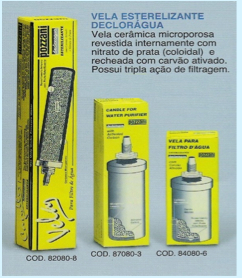Kisii filter bucket
The Kisii Filter bucket has been developed in collaboration with the Rural Water Development (RWD) Project in Kisii, Western Kenya in 2003, as a response to the low quality of household water and water from springs and wells in that area.
This low cost technology was also very much appreciated in Nairobi, where most people boil the water from the tap. The Kisii bucket has become increasingly popular, as well in the rural areas as in the towns were people have water from the tap and many NGOs are now also promoting this simple system.
The specific idea of the “Kisii Filter Bucket” is to use low cost transparent PVC containers with a ceramic filter to compose a water filter system.
The upper bucket has a “standard” (normally available on the market) ceramic filter, the filtered water drips into the lower PVC bucket and can be used with a small tap. The lower bucket is well closed for safe storage.
Contents
Suitable conditions
| Advantages | Disadvantages |
|---|---|
| - Safe and clean water in sufficient quantities is always available at home. - Due to the low cost, safe water now becomes available for a large group of people. |
Construction, operations and maintenance
Build the system
- Remove the candle from the box and clean the outside of the filter with water, always avoid touching the filterstone with your hands; hold the filter at the bottom.
- Put the sprout of the filter candle in the hole(s) in the bottom of the top bucket and also through the hole(s) in the cover of the lower bucket.
- Make sure that on the lower side and on the topside the sprout is sealed with the rubber seals, firmly attach the bolt to avoid leakage around the sprout.
- Place the cover with the filter bucket attached to it on the lower bucket.
- Fill the top filter bucket with water, use a scoop.
- Within some minutes, the water will drip out of the filter; the first water can contain some dirt, so throw away the first litres of water and only start using the filter after that.
Maintenance

The filter system needs only a minimum of maintenance (regular cleaning of the outside of the ceramic element and inspection and cleaning of the inside of the buckets). The filter candle can be used for six month up to several years, depending on the quality of the water to be filtered.
Two types of ceramic filters candles are recommended:
- A “slow speed” ceramic filter candle, made in India, costs about 1 US$ (in local shops) and can filter 3 litres of water per day. This candle can be impregnated with silver for additional security.
- A “high speed” filter, with additional silver and active carbon already inside, made in Brazil, costs about 3US$ and can produce 25 litres of safe water per day.
The filter bucket is transparent. Users can see how much water is present both in the filter unit and in the lower storage unit. It also is directly visible when the filter candle needs to be cleaned. This improves trust and a better management of the available water in the household.
For the best results of your filter bucket system, you should:
- Clean gently the outside of the filterstone every week to remove some dirt, use a clean brush or scotsbrite, but never use soap.
- Inspect the inside of both buckets every week and clean it when necessary.
- Keep the unit on one secure place out of the sun; do not walk around with the filter bucket.
- Use always a scoop to fill up the top bucket as much as possible, the filters works faster when the waterlevel is above the filterstone.
- Normally the filter can stay inside the bucket when cleaning. In case the filter is removed from the top bucket for cleaning or replacement, be sure that the filter is re-installed properly, with the rubber seals on place.
Manuals, videos and links
This is a very simple water filter for any type of water (from rivers, lake, ponds, rain, etc..) by putting one (or more) ceramic water filter candle in a small or large bucket. The filter has been first demonstrated and used in the Kisii Water Project in Western Kenya, by RWD (Rural Water Development Project of the Diocese of Kisii and Ngong) in 2003. Since that time many thousands have been made and are used by town and rural communities.
Each ceramic candle can give about 20 liters of pure and safe drinking water per day. By putting more candles the total yield can be increased. Maintenance is simple, after a while (depends on the water quality) on the outside of the candle some dirt may accumulate and the candle needs to be cleaned with a fine brush, NOT with soap! Soap will clog the filter and stop it from working.
The specific advantage is that the ceramic filter candles are cheap and often available as spare water filter candles for the more expensive systems from companies susch as Pozzani, Stefani and Berkely for instance. Any type of plastic bucket can be used, simply by making a small hole in the lower part of the bucket. We do not recommend to use the cheaper ceramic filter candles that are manufactured in India because it is our experience that they start to leak at the connection, so they are not safe after a while.
See also www.watsan.org
Acknowledgements
- Kisii filter bucket. Rural Water Development (RWD) Project. Found at FairWater.


